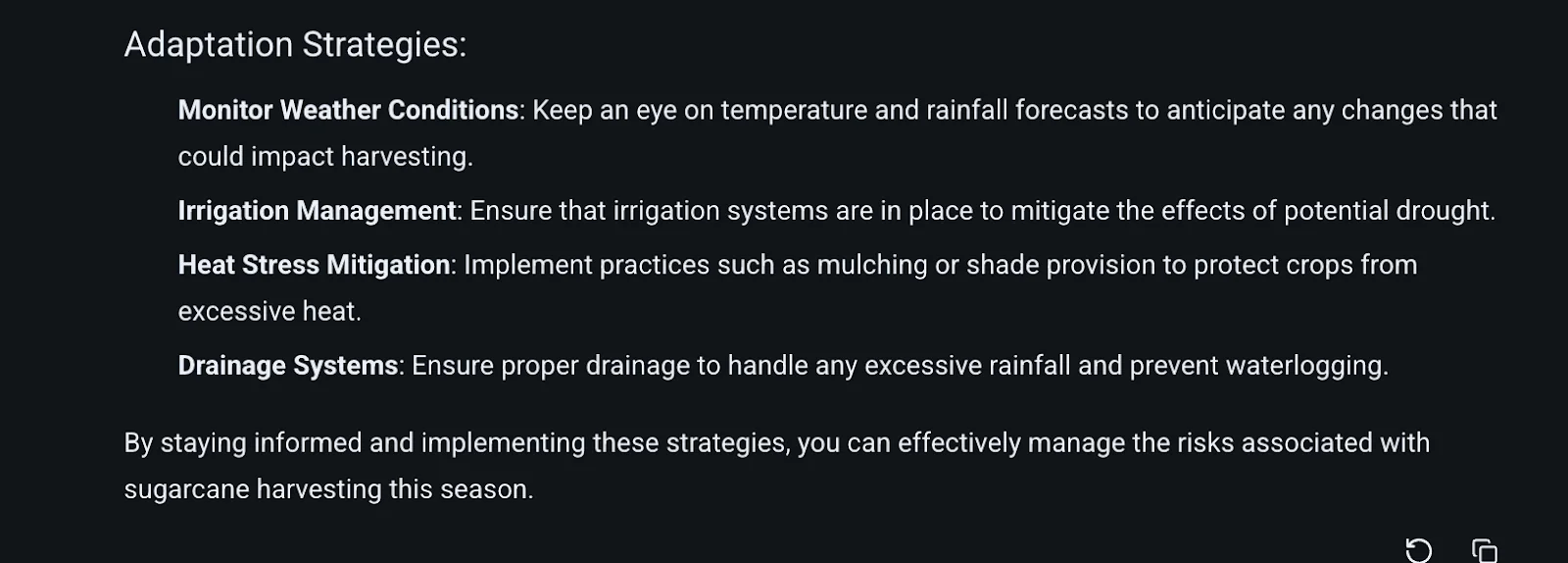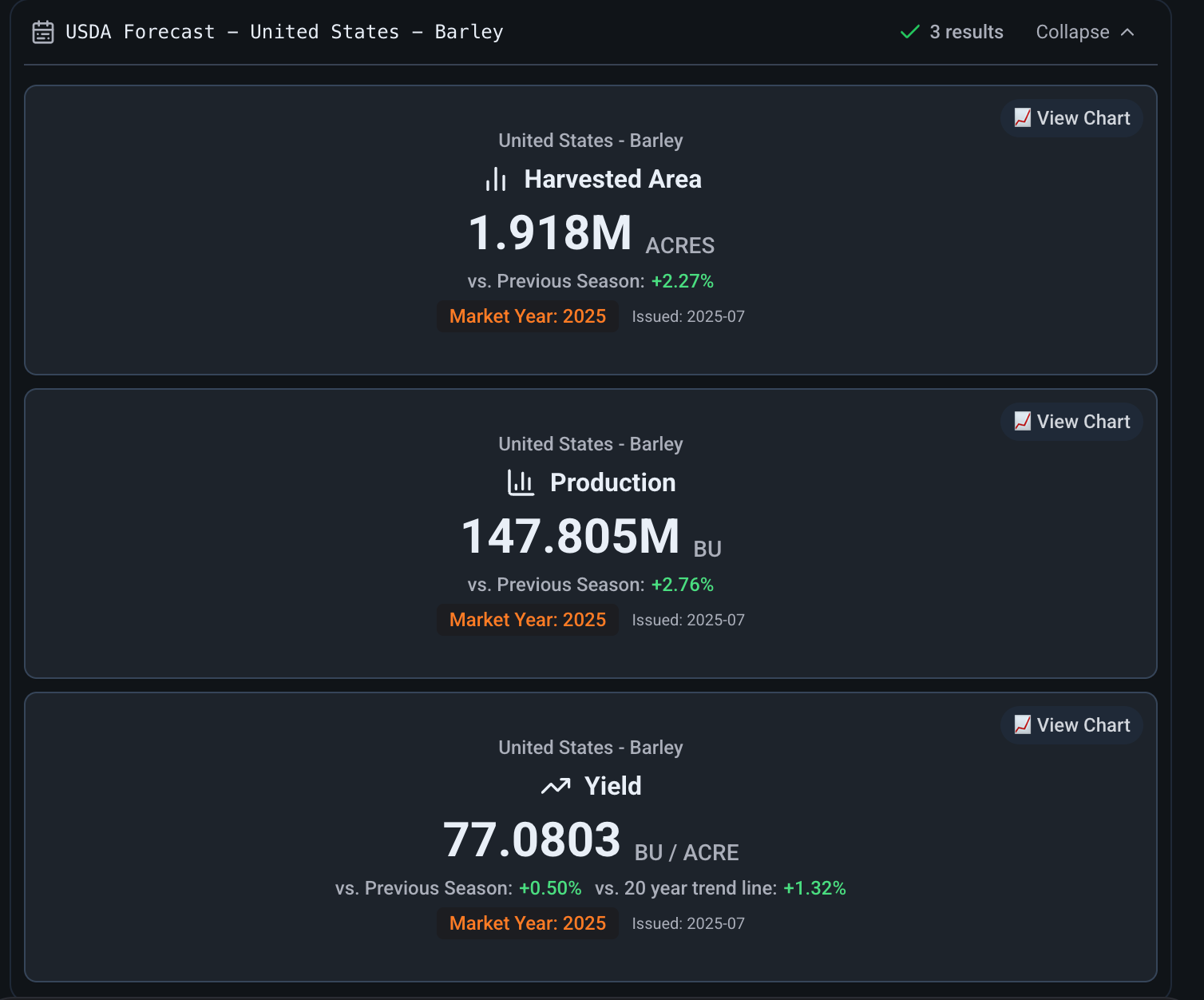Watch our latest Webinar On-Demand – 2026 Climate Adaptation Playbooks → Here
Andy Paterson • October 14th, 2025.
The tools for businesses to adapt to climate change already exist. AI-driven weather forecasts continue to improve in accuracy, granularity, and specificity, and are linked to the company-specific assets, crops they grow, and their supply chains.
Companies don’t need more data. They need simple ways to interpret and apply it. To take it over the ‘last mile.’ That’s where AI adaptation agents come in. They enable companies to easily understand how the weather will impact them and what actions they should take, all on one customizable conversational platform.
AI adaptation agents enable companies to provide frontline personnel with weather data and adaptation playbooks, facilitating on-the-ground adaptation without requiring specialized expertise. This article explores how AI agents for adaptation cover the last mile of adoption, making weather intelligence actionable and profitable
The “last mile” is where many adaptation plans fail. The translation of climate data into actionable business decisions is a challenge that many companies seem to struggle with.
Studies show that only 25% of the workforce utilizes business intelligence and data analytics tools. Meaning the data companies have is not being effectively used to make valuable decisions. Intelligence around climate adaptation faces a similar problem: companies have the data, but putting it to work is the hard part.
AI agents simplify the complexity of climate data, bridging the last mile and ensuring that data is effectively incorporated into the decision-making process.
Agents interpret raw forecast data and combine it with other agronomy, biological, and supply chain data to give data-driven insights tailored to the prompter’s company.
Companies across sectors and geographies can put an AI agent in the hands of any employee, knowing that their workers are receiving clear, tailored instructions that meet their specific needs.
It reduces dependency on a few specialized staff, scales expertise across the organization, and enables automated communications to people on the ground:
A simple text or e-mail to a supplier or producer on the ground saying, “Heavy rains are coming this week and will delay harvest 3 days. You should shift labor schedule accordingly.” Could save in staffing, operation, and logistic costs and ensure the highest possible yield and lowest price.
The business potential for adaptation is huge. In the food and beverage sector, for example, businesses can see a $19 return for every dollar spent by 2050.
However, for most businesses today, even those with weather intelligence, it remains a matter of interpretation. Employees sift through dashboards, alerts, and forecasts, each interpreting the same data differently and, in some cases, misinterpreting or unsure of what to do about it.
While a more experienced worker may act promptly and avoid losses, another may miss the signal entirely. The result is inconsistent, inefficient, and costly decision-making across regions and teams.
Instead of guessing how weather information might affect yields, operations, and supply chains, producers receive precise, actionable steps, rooted in ClimateAi’s localized forecasts and crop-specific intelligence. Based on the questions, they need to know the answer to.
With AI agents, expertise no longer depends on on-site expertise. It becomes operationalized and always on. Companies can have the confidence to act quickly and consistently, protecting yields, optimizing inputs, and scaling profitable adaptation decisions across the company.
The impact of climate change on businesses is huge. Research from BCG found that without additional adaptation, food and beverage companies could lose up to 10% of EBITDA by 2050. Global climate-related losses could reach $12.5 trillion by 2050.
AI agents will help businesses avoid losses of climate-related risks and exploit opportunities in four key ways:
Businesses can ask questions about the crops, regions, and commodities they are interested in to receive answers to climate-related questions that matter to them. They can put all the information they care about on a custom dashboard that updates as the weather changes.
Certain weather conditions can trigger workflows that warn suppliers of impending weather events and provide them with guidance on how to mitigate potential losses. The natural-language interfaces can then be shared on communication sites, such as emails, Slack, or SMS, with anyone within the company.
To show how the agent works in practice, the two use cases below give a little taste of how AI agents for adaptation can help businesses benefit from climate adaptation.
A sugarcane buyer with suppliers approaching harvest in São Paulo, Brazil, opens ClimateAi’s agent and asks:
“Will there be precipitation in São Paulo, Brazil, over the next month?”

Within seconds, the agent analyzes short- and medium-term precipitation forecasts, highlighting that rainfall is expected to remain below average, with intermittent peaks, which could potentially impact harvesting logistics.


The grower follows up:
“How could this affect the sugarcane harvest?”
The agent explains that low precipitation poses minimal risk to yield but advises adjusting harvest timing to avoid expected rain bursts. It also suggests contingency measures for future rainfall extremes, helping the grower plan irrigation and labor more efficiently.


The supplier can then send all this information to their suppliers in the area, ensuring they optimize yield, and add it to a dashboard to track progress.
By transforming complex seasonal forecasts into simple, actionable guidance, ClimateAi’s agent closes the interpretation gap that has long slowed agricultural decisions. These can be generated from specific prompts or from event-triggered workflows that provide alerts and recommendations.
Buyers move from reactive to proactive, saving time, reducing costs, and standardizing best practices across teams and geographies. What once required an agronomist’s deep expertise is now available to every producer, instantly and at scale.
An agricultural commodity investor opens ClimateAi’s agent and asks:
“What’s the latest USDA forecast for barley in the U.S.?”

The agent retrieves the newest USDA data on harvested area, production, and yield, showing modest year-on-year increases that could pressure prices downward.


The investor then asks:
“What might this mean for barley prices this season?”

Using ClimateAi’s own yield and risk outlooks, the agent can then compare USDA projections with climate-adjusted forecasts, identifying potential heat and drought risks in key production regions.
It flags a scenario where ClimateAi’s projections diverge significantly from USDA expectations, signaling an opportunity to secure commodity prices early before market adjustments occur.
For commodity investors and those in the food and beverage sector, this transforms weather data into a strategic advantage. Agents accelerate decision cycles by merging market and climate intelligence, surfacing price risks sooner, and empowering teams to act before disruptions materialize in the market.
Instead of parsing reports or waiting for expert interpretation, decision-makers get immediate, data-backed insights in the same workflow they already use.
Having the data to make decisions is great, but having the decisions ready-made is better. That’s how AI agents help companies get over the ‘last mile’ of adaptation quickly, moving interpretation into implementation.
One of the most significant gaps in adaptation adoption is the skills and expertise gap. AI Adaptation Agents bridge that gap. Giving users automated data interpretation in clear language that anyone can understand, and providing actionable, easy-to-follow insights.
Find out more about how ClimateAi’s agent can get your adaptation strategies across the last mile here.

Andy Paterson is a content creator and strategist at ClimateAi. Before joining the team, he was a content leader at various climate and sustainability start-ups and enterprises.
Andy has held writing, content strategy, and editing roles at BCG, Persefoni, and Good.Lab. He has helped build one of the industry’s most popular newsletters and regularly publishes environmental science articles with Research Publishing.